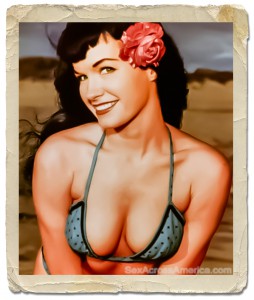 (12/23/13) What is erotica? Is it art? Is it porn? Is it neither or both? Some say the answer lies with the intent of the subject while others opine that it’s whatever the social majority says it is. If you randomly ask any 10 people, you’ll likely get about 47 different answers. Defining erotica is very much like firing a floppy rubber band at an ever-zipping target. The definition not only fluctuates depending on where you happen to be at any given moment, but also when that given moment happens to be. You would think that something that’s been around since cave dwelling days might be more solidly classified by now, but if anything it’s become fuzzier in the modern era. Perhaps that’s not such a bad thing though.
(12/23/13) What is erotica? Is it art? Is it porn? Is it neither or both? Some say the answer lies with the intent of the subject while others opine that it’s whatever the social majority says it is. If you randomly ask any 10 people, you’ll likely get about 47 different answers. Defining erotica is very much like firing a floppy rubber band at an ever-zipping target. The definition not only fluctuates depending on where you happen to be at any given moment, but also when that given moment happens to be. You would think that something that’s been around since cave dwelling days might be more solidly classified by now, but if anything it’s become fuzzier in the modern era. Perhaps that’s not such a bad thing though.
Paraphrasing Supreme Court Associate Justice Potter Stewart’s famous 1964 statement supporting the Court’s overturning an Ohio obscenity conviction, “…I shall not today attempt further to define the kinds of material I understand to be embraced, but I know it when I see it.” It’s one of those rare, elegant occurrences where intentional ambiguity and sharp precision collide in a way that’s just perfect. By leaving the “erotica bin” deliberately vague, much more freedom is preserved when it comes to what’s Constitutionally protected as free expression. That said, the political and legal skirmishes hardly ended there.
In 1973, the Supreme Court ruled in a California obscenity case, resulting in a three step assessment to resolve whether a written or visual artwork was Constitutionally protected or classified as “obscene” and therefore not covered by the First Amendment. The so-called “Miller Test” offered these guidelines:
1. Whether the average person, applying contemporary community standards would find that the work, taken as a whole, appeals to the prurient interest;
2. Whether the work depicts or describes, in a patently offensive way, sexual conduct specifically defined by the applicable state law, and;
3. Whether the work, taken as a whole, lacks serious literary, artistic, political, or scientific value.
While many states still have laws that would apply in defining obscene material, the issue of “contemporary community standards” is both vague and constantly changing. As they’ve essentially become more liberal over the years, particularly with new and expanded forms of media, the Miller Test has increasingly helped to protect many forms of erotica when challenged in the justice system. Accordingly, the uberstuffy types had to up their creativity when instigating clashes, but not necessarily achieving the intended results.
In 1989, for example, Robert Mapplethorpe‘s art exhibit, publicly funded by the National Endowment for the Arts, came under attack by conservative special interest groups under the guise of opposing public subsidies for art that they deemed obscene. Applying powerful lobbying tactics, they managed to influence withdrawal of support for Mapplethorpe’s show along with a subsequent obscenity prosecution of a venue that proceeded with the exhibition. While their strategy initially appeared to succeed, it ultimately backfired massively when the venue (the Contemporary Arts Center in Cincinnati, Ohio) was found not guilty in the resulting jury trial and the entire escapade elevated Mapplethorpe to celebrity status, significantly increasing both the exposure and monetary value of his art.
These days, erotic artists are thriving as the mainstream has widened its view of what is considered–and accepted–as art. This isn’t to say that opposition camps have dissolved completely, of course, but it does seem that a greater degree of tolerance is now in the air. It’s a positive trend that not only solidifies freedom, but ironically owes itself to the lack of a clear, universal definition.
However, you do know it when you see it.

I’ve always felt that the “Is it erotic?” question can be handled nicely by Goya’s two paintings, “The Clothed Maja,” and “The Naked Maja.” The paintings, in which the woman is laying on a bed looking quite relaxed and voluptuous in both poses, are BOTH erotic, I would argue, because the clothed one invites the viewer to imagine the woman naked, and the naked one looks like a woman just after sex and relaxed. Interestingly, though I can’t recall the name of the college, the showing of both paintings in an art history class created a very similar “Is it ‘dirty’ or is it art?” PC controversy. My response would have been, “These are works by Goya, one of the great masters of art, who should NEVER be subject to censorship by the ignorant. Study his work and learn from it. Your politics–right or left–just don’t matter.”
Dwyer,
Foremost, thank you for taking the time to comment. We appreciate your point of view and hope that other readers will consider it when offering their thoughts as well.
Your post brings up an interesting element in the sense that the fame (or infamy, as the case may be) of a particular artist/author certainly does have a lot to do with how with how their work is perceived. However, that begs the question: Should one have to be considered as “one of the greats” in order to get an autopass from censorship?
Hmm. Something to think about.
Have a wonderful holiday!